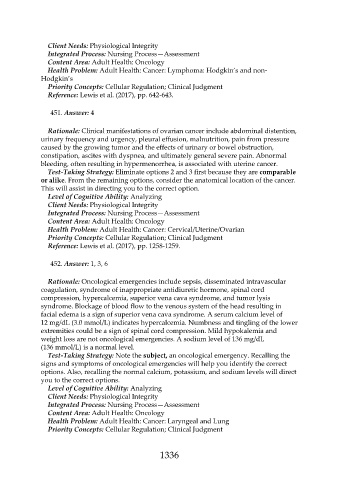Page 1336 - Saunders Comprehensive Review For NCLEX-RN
P. 1336
Client Needs: Physiological Integrity
Integrated Process: Nursing Process—Assessment
Content Area: Adult Health: Oncology
Health Problem: Adult Health: Cancer: Lymphoma: Hodgkin’s and non-
Hodgkin’s
Priority Concepts: Cellular Regulation; Clinical Judgment
Reference: Lewis et al. (2017), pp. 642-643.
451. Answer: 4
Rationale: Clinical manifestations of ovarian cancer include abdominal distention,
urinary frequency and urgency, pleural effusion, malnutrition, pain from pressure
caused by the growing tumor and the effects of urinary or bowel obstruction,
constipation, ascites with dyspnea, and ultimately general severe pain. Abnormal
bleeding, often resulting in hypermenorrhea, is associated with uterine cancer.
Test-Taking Strategy: Eliminate options 2 and 3 first because they are comparable
or alike. From the remaining options, consider the anatomical location of the cancer.
This will assist in directing you to the correct option.
Level of Cognitive Ability: Analyzing
Client Needs: Physiological Integrity
Integrated Process: Nursing Process—Assessment
Content Area: Adult Health: Oncology
Health Problem: Adult Health: Cancer: Cervical/Uterine/Ovarian
Priority Concepts: Cellular Regulation; Clinical Judgment
Reference: Lewis et al. (2017), pp. 1258-1259.
452. Answer: 1, 3, 6
Rationale: Oncological emergencies include sepsis, disseminated intravascular
coagulation, syndrome of inappropriate antidiuretic hormone, spinal cord
compression, hypercalcemia, superior vena cava syndrome, and tumor lysis
syndrome. Blockage of blood flow to the venous system of the head resulting in
facial edema is a sign of superior vena cava syndrome. A serum calcium level of
12 mg/dL (3.0 mmol/L) indicates hypercalcemia. Numbness and tingling of the lower
extremities could be a sign of spinal cord compression. Mild hypokalemia and
weight loss are not oncological emergencies. A sodium level of 136 mg/dL
(136 mmol/L) is a normal level.
Test-Taking Strategy: Note the subject, an oncological emergency. Recalling the
signs and symptoms of oncological emergencies will help you identify the correct
options. Also, recalling the normal calcium, potassium, and sodium levels will direct
you to the correct options.
Level of Cognitive Ability: Analyzing
Client Needs: Physiological Integrity
Integrated Process: Nursing Process—Assessment
Content Area: Adult Health: Oncology
Health Problem: Adult Health: Cancer: Laryngeal and Lung
Priority Concepts: Cellular Regulation; Clinical Judgment
1336

